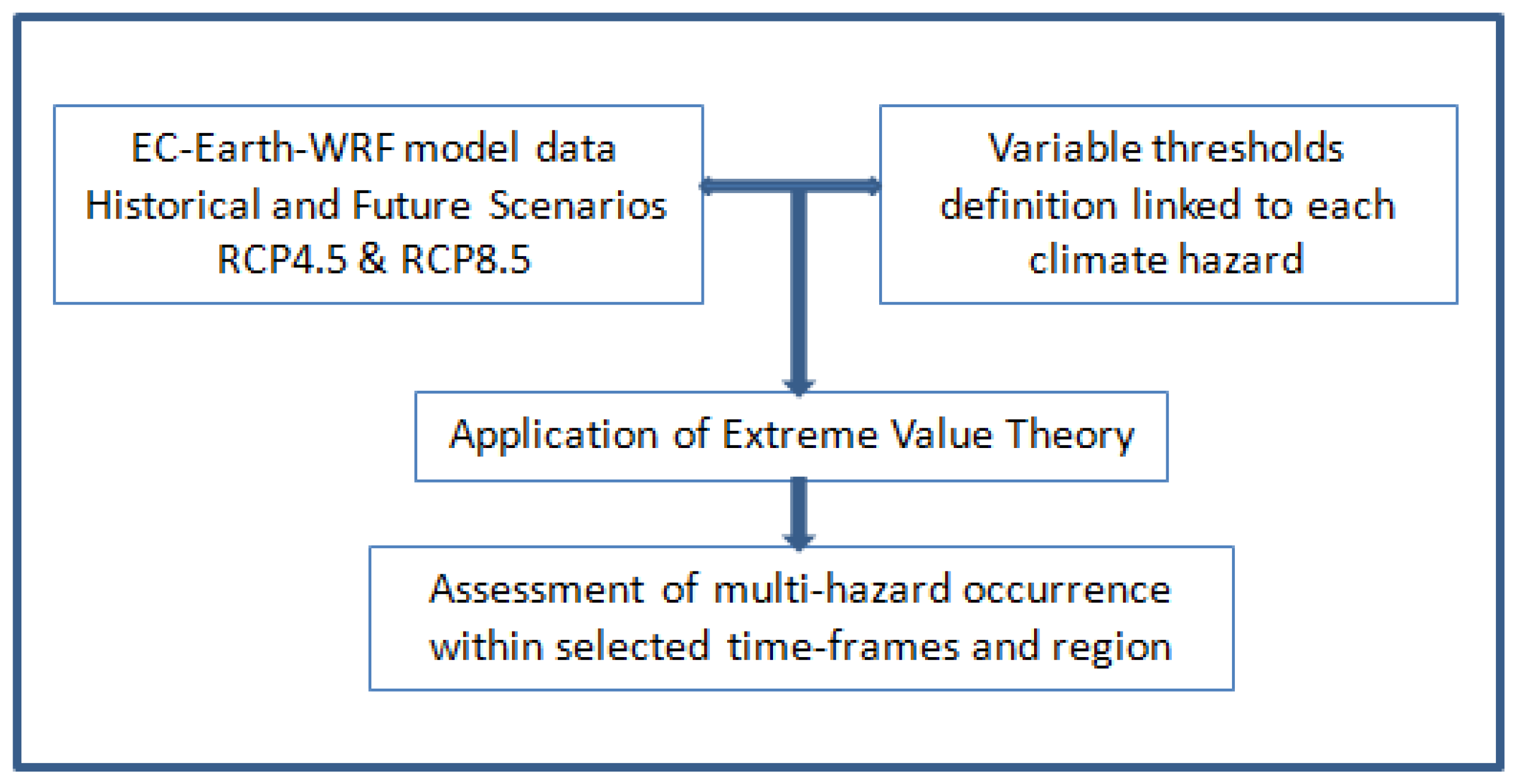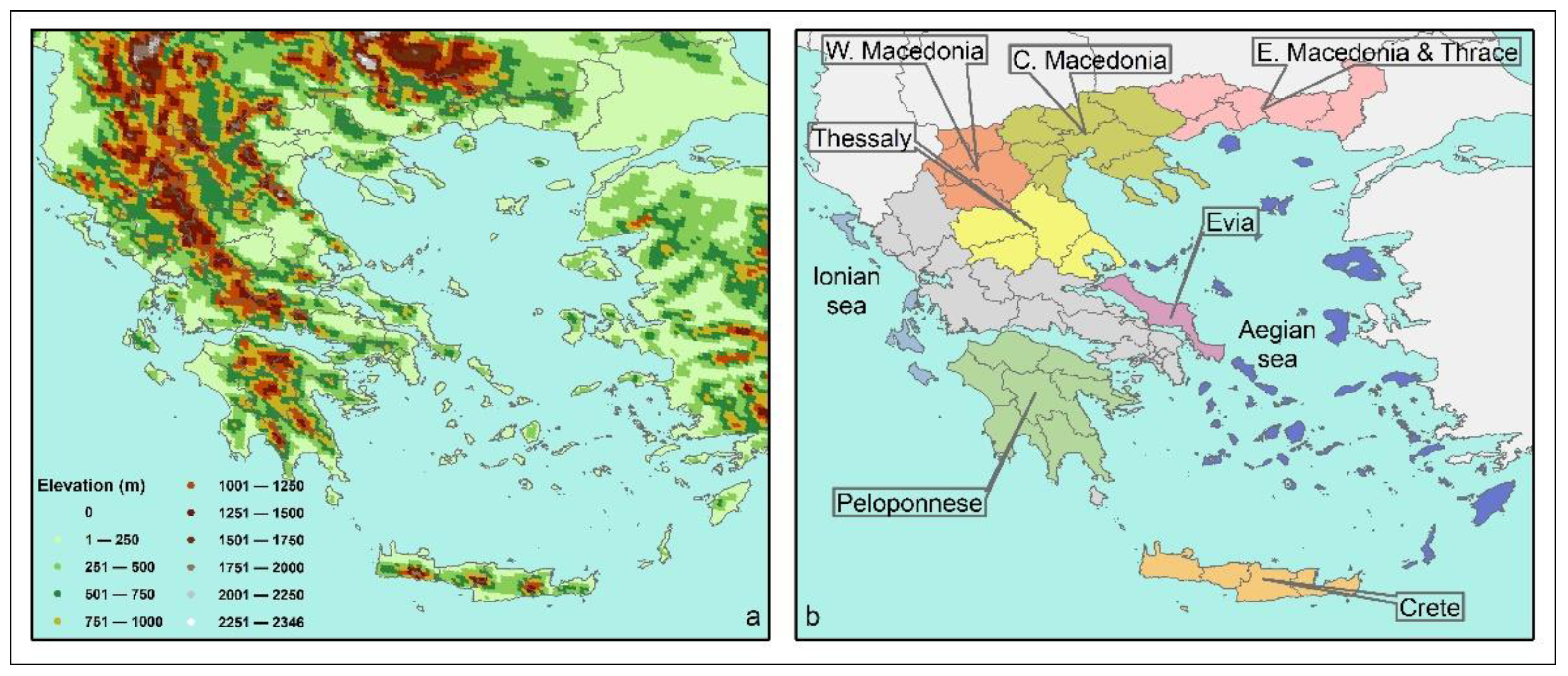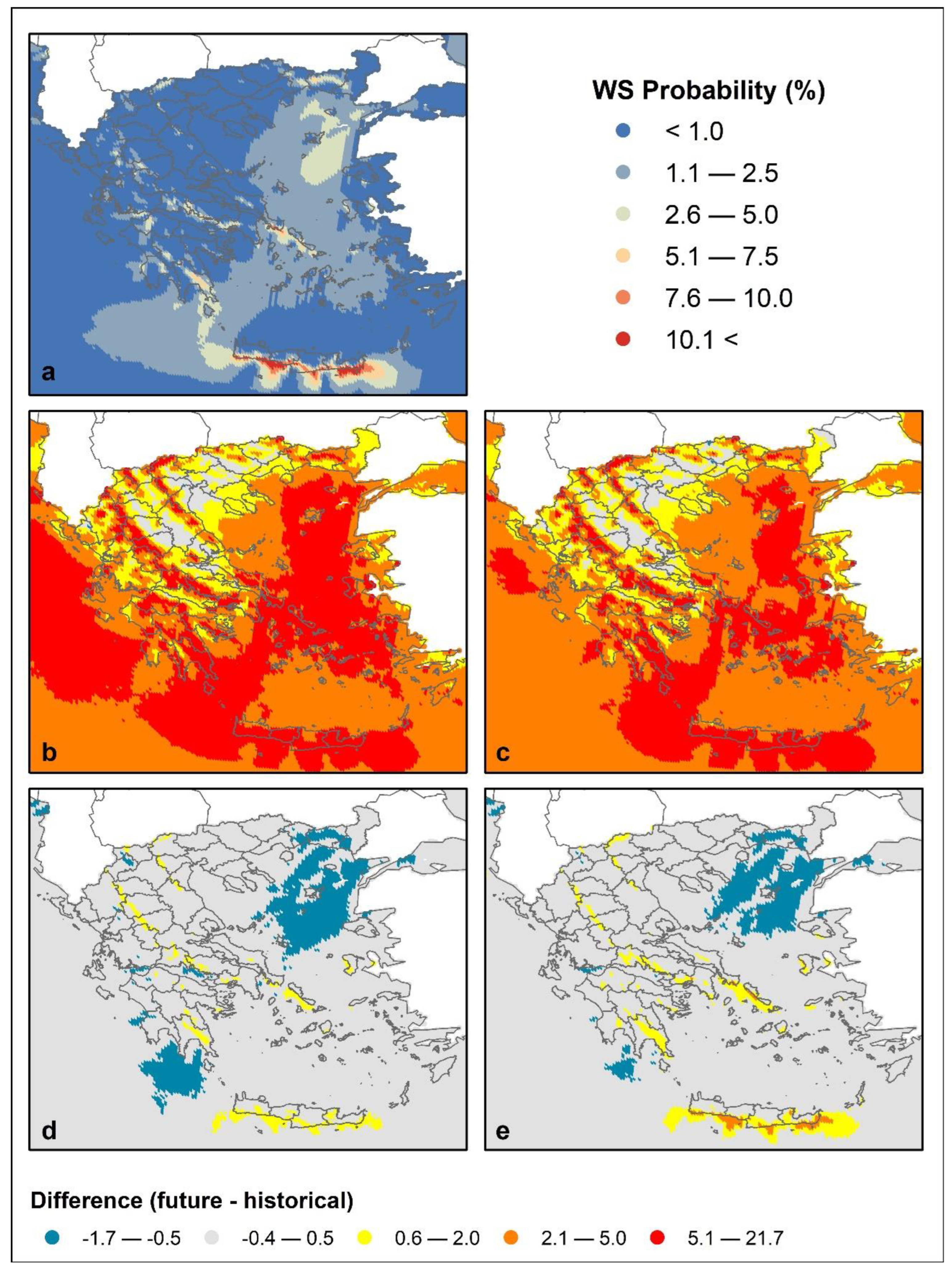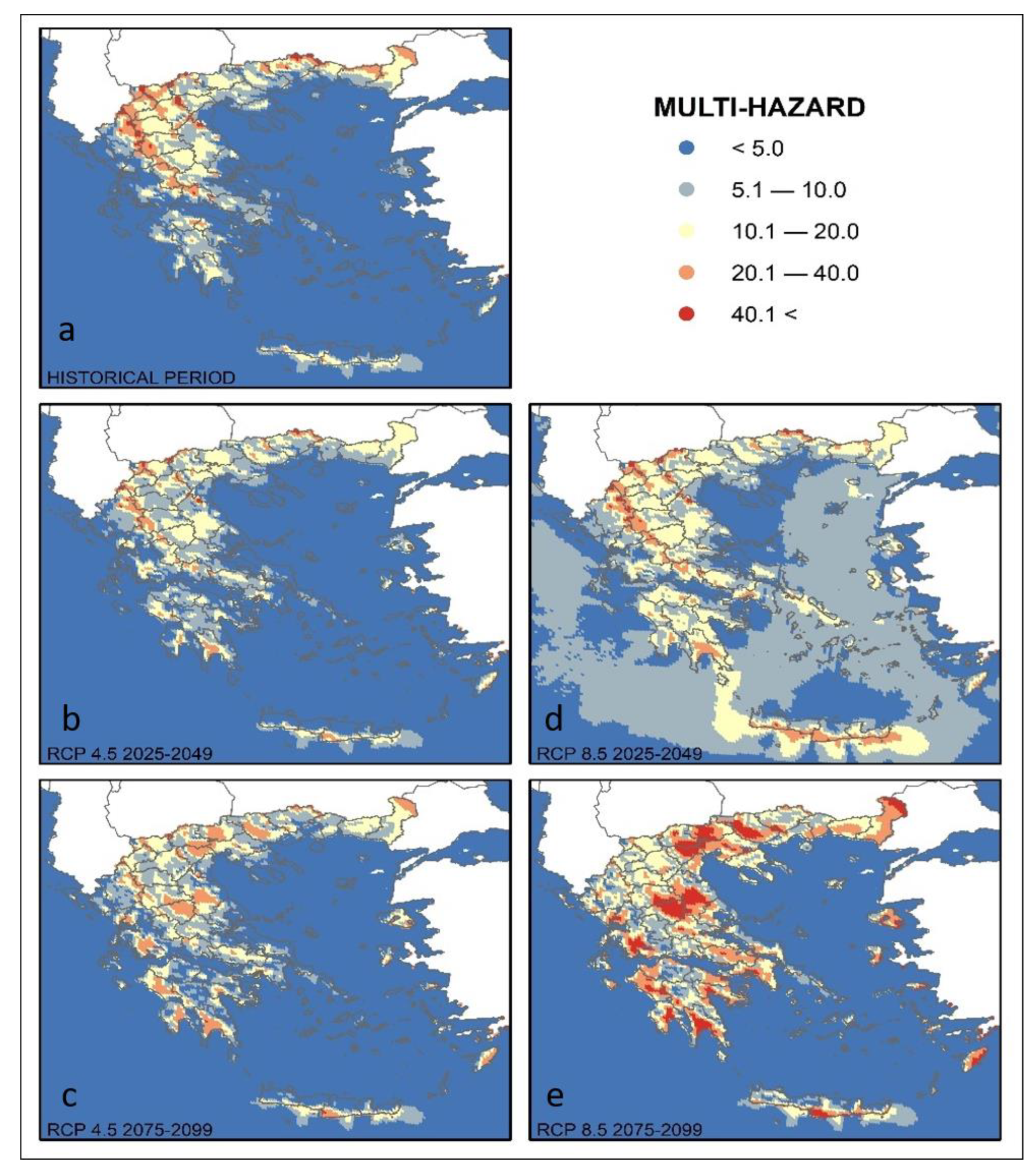Quantifying the Occurrence of Multi-Hazards Due to Climate Change
Abstract
1. Introduction
2. Materials and Methods
2.1. Area of the Study and Model Datasets
2.2. Statistical Tools and Data Processing
- When ξ = 0, GEV is known also as Type I Extreme Value Distribution (or Gumbel Distribution, light tail)
- When ξ > 0, GEV is known also as Type II Extreme Value Distribution (or Frechet Distribution, heavy tail)
- When ξ < 0, GEV is known also as Type III Extreme Value Distribution (or Weibull Distribution, upper finite end point).
3. Results and Discussion
3.1. Maximum Temperature
3.2. Minimum Temperature
3.3. Precipitation Rate
3.4. Wind
3.5. Multi-Hazard Probability Maps
4. Conclusions
Author Contributions
Funding
Institutional Review Board Statement
Informed Consent Statement
Data Availability Statement
Acknowledgments
Conflicts of Interest
References
- IPCC; Masson-Delmotte, V.; Zhai, P.; Pirani, A.; Connors, S.L.; Péan, C.; Berger, S.; Caud, N.; Chen, Y.; Goldfarb, L.; et al. Climate Change 2021: The Physical Science Basis. Contribution of Working Group I to the Sixth Assessment Report of the Intergovernmental Panel on Climate Change; Cambridge University Press: Geneva, Switzerland, 2021; Available online: https://www.ipcc.ch/report/ar6/wg1/ (accessed on 1 December 2021).
- Fischer, E.M.; Sippel, S.; Knutti, R. Increasing probability of record-shattering climate extremes. Nat. Clim. Chang. 2021, 11, 689–695. [Google Scholar] [CrossRef]
- Guerreiro, S.B.; Fowler, H.J.; Barbero, R.; Westra, S.; Lenderink, G.; Blenkinsop, S.; Lewis, E.; Li, X.F. Detection of continental-scale intensification of hourly rainfall extremes. Nat. Clim. Chang. 2018, 8, 803–807. [Google Scholar] [CrossRef]
- WMO Climate and Weather Related Disasters Surge Five-Fold over 50 Years, but Early Warnings Save Lives. Available online: https://news.un.org/en/story/2021/09/1098662 (accessed on 30 September 2021).
- NOAA National Centers for Environmental Information (NCEI) Billion-Dollar Weather and Climate Disasters: FAQ|National Centers for Environmental Information (NCEI). Available online: https://www.ncdc.noaa.gov/billions/ (accessed on 30 September 2021).
- European Environment Agency Economic Losses from Climate-Related Extremes in Europe. Available online: https://www.eea.europa.eu/data-and-maps/indicators/direct-losses-from-weather-disasters-4/assessment (accessed on 30 September 2021).
- Gampe, D.; Zscheischler, J.; Reichstein, M.; O’Sullivan, M.; Smith, W.K.; Sitch, S.; Buermann, W. Increasing impact of warm droughts on northern ecosystem productivity over recent decades. Nat. Clim. Chang. 2021, 11, 772–779. [Google Scholar] [CrossRef]
- van Vliet, M.T.H.; van Beek, L.P.H.; Eisner, S.; Flörke, M.; Wada, Y.; Bierkens, M.F.P. Multi-model assessment of global hydropower and cooling water discharge potential under climate change. Glob. Environ. Chang. 2016, 40, 156–170. [Google Scholar] [CrossRef]
- Schewe, J.; Gosling, S.N.; Reyer, C.; Zhao, F.; Ciais, P.; Elliott, J.; Francois, L.; Huber, V.; Lotze, H.K.; Seneviratne, S.I.; et al. State-of-the-art global models underestimate impacts from climate extremes. Nat. Commun. 2019, 10, 1005. [Google Scholar] [CrossRef]
- Monier, E.; Paltsev, S.; Sokolov, A.; Chen, Y.-H.H.; Gao, X.; Ejaz, Q.; Couzo, E.; Schlosser, C.A.; Dutkiewicz, S.; Fant, C.; et al. Toward a consistent modeling framework to assess multi-sectoral climate impacts. Nat. Commun. 2018, 9, 660. [Google Scholar] [CrossRef]
- Sillmann, J.; Sippel, S.; Russo, S. Climate Extremes and Their Implications for Impact and Risk Assessment; Elsevier: Amsterdam, The Netherlands, 2019; pp. 1–9. [Google Scholar] [CrossRef]
- Otto, F.E.L.; Van Oldenborgh, G.J.; Eden, J.; Stott, P.A.; Karoly, D.J.; Allen, M.R. The attribution question. Nat. Clim. Chang. 2016, 6, 813–816. [Google Scholar] [CrossRef]
- Hoegh-Guldberg, O.; Jacob, D.; Taylor, M.; Bindi, M.; Abdul Halim, S.; Achlatis Australia, M.; Alexander, L.V.; Allen, M.R.; Berry, P.; Boyer, C.; et al. Impacts of 1.5 °C global warming on natural and human systems. In Global Warming of 1.5 °C. An IPCC Special Report on the Impacts of Global Warming of 1.5 °C above Pre-Industrial Levels and Related Global Greenhouse Gas Emission Pathways, in the Context of Strengthening the Global Response to the Threat of Climate Change, Sustainable Development, and Efforts to Eradicate; IPCC Secretariat: Geneva, Switzerland, 2018; pp. 175–311. [Google Scholar]
- Lehmann, J.; Coumou, D.; Frieler, K. Increased record-breaking precipitation events under global warming. Clim. Change 2015, 132, 501–515. [Google Scholar] [CrossRef]
- Ribes, A.; Zwiers, F.W.; Azaïs, J.M.; Naveau, P. A new statistical approach to climate change detection and attribution. Clim. Dyn. 2017, 48, 367–386. [Google Scholar] [CrossRef]
- King, A.D. Attributing Changing Rates of Temperature Record Breaking to Anthropogenic Influences. Earth’s Futur. 2017, 5, 1156–1168. [Google Scholar] [CrossRef]
- Van Der Wiel, K.; Kapnick, S.B.; Jan Van Oldenborgh, G.; Whan, K.; Philip, S.; Vecchi, G.A.; Singh, R.K.; Arrighi, J.; Cullen, H. Rapid attribution of the August 2016 flood-inducing extreme precipitation in south Louisiana to climate change. Hydrol. Earth Syst. Sci. 2017, 21, 897–921. [Google Scholar] [CrossRef]
- Diffenbaugh, N.S.; Singh, D.; Mankin, J.S.; Horton, D.E.; Swain, D.L.; Touma, D.; Charland, A.; Liu, Y.; Haugen, M.; Tsiang, M.; et al. Quantifying the influence of global warming on unprecedented extreme climate events. Proc. Natl. Acad. Sci. USA 2017, 114, 4881–4886. [Google Scholar] [CrossRef] [PubMed]
- Marsooli, R.; Lin, N.; Emanuel, K.; Feng, K. Climate change exacerbates hurricane flood hazards along US Atlantic and Gulf Coasts in spatially varying patterns. Nat. Commun. 2019, 10, 3785. [Google Scholar] [CrossRef] [PubMed]
- Ali, H.; Modi, P.; Mishra, V. Increased flood risk in Indian sub-continent under the warming climate. Weather Clim. Extrem. 2019, 25, 100212. [Google Scholar] [CrossRef]
- Coogan, S.C.P.; Robinne, F.N.; Jain, P.; Flannigan, M.D. Scientists’ warning on wildfire—A canadian perspective. Can. J. For. Res. 2019, 49, 1015–1023. [Google Scholar] [CrossRef]
- Mezősi, G.; Bata, T.; Meyer, B.C.; Blanka, V.; Ladányi, Z. Climate Change Impacts on Environmental Hazards on the Great Hungarian Plain, Carpathian Basin. Int. J. Disaster Risk Sci. 2014, 5, 136–146. [Google Scholar] [CrossRef][Green Version]
- Cook, B.I.; Mankin, J.S.; Anchukaitis, K.J. Climate Change and Drought: From Past to Future. Curr. Clim. Chang. Rep. 2018, 4, 164–179. [Google Scholar] [CrossRef]
- Pereira, S.C.; Carvalho, D.; Rocha, A. Temperature and Precipitation Extremes over the Iberian Peninsula under Climate Change Scenarios: A Review. Climate 2021, 9, 139. [Google Scholar] [CrossRef]
- Savi, S.; Comiti, F.; Strecker, M.R. Pronounced increase in slope instability linked to global warming: A case study from the eastern European Alps. Earth Surf. Processes Landf. 2021, 46. [Google Scholar] [CrossRef]
- Tijdeman, E.; Hannaford, J.; Stahl, K. Human influences on streamflow drought characteristics in England and Wales. Hydrol. Earth Syst. Sci. 2018, 22, 1051–1064. [Google Scholar] [CrossRef]
- Cammalleri, C.; Naumann, G.; Mentaschi, L.; Bisselink, B.; Gelati, E.; De Roo, A.; Feyen, L. Diverging hydrological drought traits over Europe with global warming. Hydrol. Earth Syst. Sci. 2020, 24, 5919–5935. [Google Scholar] [CrossRef]
- Sieck, K.; Nam, C.; Bouwer, L.M.; Rechid, D.; Jacob, D. Weather extremes over Europe under 1.5 and 2.0 °C global warming from HAPPI regional climate ensemble simulations. Earth Syst. Dyn. 2021, 12, 457–468. [Google Scholar] [CrossRef]
- Suarez-Gutierrez, L.; Li, C.; Müller, W.A.; Marotzke, J. Internal variability in European summer temperatures at 1.5 °C and 2 °C of global warming. Environ. Res. Lett. 2018, 13, 064026. [Google Scholar] [CrossRef]
- Forzieri, G.; Bianchi, A.; Silva, F.B.; Marin Herrera, M.A.; Leblois, A.; Lavalle, C.; Aerts, J.C.J.H.; Feyen, L. Escalating impacts of climate extremes on critical infrastructures in Europe. Glob. Environ. Chang. 2018, 48, 97–107. [Google Scholar] [CrossRef]
- Feyen, L.; Ciascar, J.; Gosling, S.; Ibarreta, D.; Soria, A.; Dosio, A.; Naumann, G.; Russo, S.; Formetta, G.; Forzieri, G.; et al. JRC Science for Policy Report; Joint Research Centre: Petten, The Netherlands, 2020. [Google Scholar]
- The United Nations Office for Disaster Risk Reduction Proposed Updated Terminology on Disaster Risk Reduction: A Technical Review. Available online: http://www.unisdr.org/we/inform/terminology (accessed on 8 October 2021).
- EUR 30596 EN. JRC Recommendations for National Risk Assessment for Disaster Risk Management in EU: Where Science and Policy Meet; Publications Office of the European Union: Luxembourg, 2021; Version 1; p. 273. Available online: https://data.europa.eu/doi/10.2760/43449 (accessed on 1 December 2021).
- Kappes, M.S.; Keiler, M.; von Elverfeldt, K.; Glade, T. Challenges of analyzing multi-hazard risk: A review. Nat. Hazards 2012, 64, 1925–1958. [Google Scholar] [CrossRef]
- Tilloy, A.; Malamud, B.D.; Winter, H.; Joly-Laugel, A. A review of quantification methodologies for multi-hazard interrelationships. Earth-Science Rev. 2019, 196, 102881. [Google Scholar] [CrossRef]
- Gallina, V.; Torresan, S.; Critto, A.; Sperotto, A.; Glade, T.; Marcomini, A. A review of multi-risk methodologies for natural hazards: Consequences and challenges for a climate change impact assessment. J. Environ. Manag. 2016, 168, 123–132. [Google Scholar] [CrossRef]
- Sperotto, A.; Molina, J.L.; Torresan, S.; Critto, A.; Marcomini, A. Reviewing Bayesian Networks potentials for climate change impacts assessment and management: A multi-risk perspective. J. Environ. Manag. 2017, 202, 320–331. [Google Scholar] [CrossRef]
- Skamarock, W.C.; Skamarock, W.C.; Klemp, J.B.; Dudhia, J.; Gill, D.O.; Barker, D.M.; Wang, W.; Powers, J.G. A Description of the Advanced Research WRF Version 3. NCAR Technical Note -475+STR; University Corporation for Atmospheric Research: Boulder, CO, USA, 2008. [Google Scholar]
- Doblas Reyes, F.; Acosta Navarro, J.C.; Acosta Cobos, M.C.; Bellprat, O.; Bilbao, R.; Castrillo Melguizo, M.; Fuckar, N.; Guemas, V.; Lledó Ponsati, L.; Menegoz, M. Using EC-Earth for Climate Prediction Research; European Centre for Medium-Range Weather Forecasts (ECMWF): Reading, UK, 2018; Volume 154, pp. 35–40. [Google Scholar]
- Kc, B.; Shepherd, J.M.; King, A.W.; Johnson Gaither, C. Multi-hazard climate risk projections for the United States. Nat. Hazards 2021, 105, 1963–1976. [Google Scholar] [CrossRef]
- Jay, A.D.R.; Reidmiller, C.W.; Avery, D.; Barrie, B.J.; DeAngelo, A.; Dave, M.; Dzaugis, M.; Kolian, K.L.M.; Lewis, K.; Reeves, D. Winner, Overview. In Impacts, Risks, and Adaptation in the United States: Fourth National Climate Assessment, Volume II; Reidmiller, D.R., Avery, C.W., Easterling, D.R., Kunkel, K.E., Lewis, K.L.M., Maycock, T.K., Stewart, B.C., Eds.; U.S. Global Change Research Program: Washington, DC, USA, 2018; pp. 33–71. [Google Scholar] [CrossRef]
- Lhotka, O.; Kyselý, J.; Plavcová, E. Evaluation of major heat waves’ mechanisms in EURO-CORDEX RCMs over Central Europe. Clim. Dyn. 2018, 50, 4149–4262. [Google Scholar] [CrossRef]
- Cardoso, R.M.; Soares, P.M.M.; Lima, D.C.A.; Miranda, P.M.A. Mean and extreme temperatures in a warming climate: EURO CORDEX and WRF regional climate high-resolution projections for Portugal. Clim. Dyn. 2019, 52, 129–157. [Google Scholar] [CrossRef]
- Tian, L.; Jin, J.; Wu, P.; Niu, G.Y.; Zhao, C. High-resolution simulations of mean and extreme precipitation with WRF for the soil-erosive Loess Plateau. Clim. Dyn. 2020, 54, 3489–3506. [Google Scholar] [CrossRef]
- Katopodis, T.; Markantonis, I.; Vlachogiannis, D.; Politi, N.; Sfetsos, A. Assessing climate change impacts on wind characteristics in Greece through high-resolution regional climate modelling. Renew. Energy 2021, 179, 427–444. [Google Scholar] [CrossRef]
- UNDRR International Science Council Sendai. Hazard Definition & Classification Review: Technical Report; UNDRR: Panama City, Panama, 2020. [Google Scholar]
- Politi, N.; Vlachogiannis, D.; Sfetsos, A.; Nastos, P.T. High-resolution dynamical downscaling of ERA-Interim temperature and precipitation using WRF model for Greece. Clim. Dyn. 2021, 57, 1–27. [Google Scholar] [CrossRef]
- Politi, N.; Sfetsos, A.; Vlachogiannis, D.; Nastos, P.T.; Karozis, S. A sensitivity study of high-resolution climate simulations for Greece. Climate 2020, 8, 44. [Google Scholar] [CrossRef]
- Politi, N.; Nastos, P.T.; Sfetsos, A.; Vlachogiannis, D.; Dalezios, N.R. Evaluation of the AWR-WRF model configuration at high-resolution over the domain of Greece. Atmos. Res. 2018, 208, 229–245. [Google Scholar] [CrossRef]
- Katopodis, T.; Markantonis, I.; Politi, N.; Vlachogiannis, D.; Sfetsos, A. High-resolution solar climate atlas for greece under climate change using the weather research and forecasting (WRF) model. Atmosphere 2020, 11, 761. [Google Scholar] [CrossRef]
- Habermann Nadine; Thanasis Sfetsos; Ralh Hedel; Albert Chen EU-CIRCLE, Report on Climate Related Critical Event Parameters: Deliverable 3.2. Available online: https://www.eu-circle.eu/wp-content/uploads/2018/10/D3.2.pdf (accessed on 8 November 2021).
- Gilleland, E.; Katz, R.W. New software to analyze how extremes change over time. Eos Trans. Am. Geophys. Union 2011, 92, 13–14. [Google Scholar] [CrossRef]
- Cooley, D. Return periods and return levels under climate change. In Extremes in a Changing Climate; Springer: Berlin/Heidelberg, Germany, 2013; pp. 97–114. [Google Scholar]
- Hellenic Meteorological Service Climate Atlas of Greece, 1971–2000. Available online: http://climatlas.hnms.gr/sdi/ (accessed on 18 November 2021).
- Katopodis, T.; Vlachogiannis, D.; Politi, N.; Gounaris, N.; Karozis, S.; Sfetsos, A. Assessment of climate change impacts on wind resource characteristics and the wind energy potential in Greece. J. Renew. Sustain. Energy 2019, 11, 066502. [Google Scholar] [CrossRef]
- Karozis, S.; Sfetsos, A.; Gounaris, N.; Vlachogiannis, D. An assessment of climate change impact on air masses arriving in Athens, Greece. Theor. Appl. Climatol. 2021, 145, 501–517. [Google Scholar] [CrossRef]
- Dafka, S.; Toreti, A.; Zanis, P.; Xoplaki, E.; Luterbacher, J. Twenty-First-Century Changes in the Eastern Mediterranean Etesians and Associated Midlatitude Atmospheric Circulation. J. Geophys. Res. Atmos. 2019, 124, 12741–12754. [Google Scholar] [CrossRef]
- Harvey, B.J.; Shaffrey, L.C.; Woollings, T.J. Deconstructing the climate change response of the Northern Hemisphere wintertime storm tracks. Clim. Dyn. 2015, 45, 2847–2860. [Google Scholar] [CrossRef]
- Russo, S.; Dosio, A.; Graversen, R.G.; Sillmann, J.; Carrao, H.; Dunbar, M.B.; Singleton, A.; Montagna, P.; Barbola, P.; Vogt, J.V.; et al. Magnitude of extreme heat waves in present climate and their projection in a warming world. J. Geophys. Res. Atmos. 2014, 119, 12500–12512. [Google Scholar] [CrossRef]
- Coumou, D.; Di Capua, G.; Vavrus, S.; Wang, L.; Wang, S. The influence of Arctic amplification on mid-latitude summer circulation. Nat. Commun. 2018, 9, 2959. [Google Scholar] [CrossRef]
- Chang, E.K.M.; Ma, C.G.; Zheng, C.; Yau, A.M.W. Observed and projected decrease in Northern Hemisphere extratropical cyclone activity in summer and its impacts on maximum temperature. Geophys. Res. Lett. 2016, 43, 2200–2208. [Google Scholar] [CrossRef]
- Cos, J.; Doblas-Reyes, F.; Jury, M.; Marcos, R.; Bretonnière, P.-A.; Samsó, M. The Mediterranean climate change hotspot in the CMIP5 and CMIP6 projections. Earth Syst. Dyn. Discuss. 2021, 1–26. [Google Scholar] [CrossRef]








| Dataset | Period |
|---|---|
| EC–EARTH–WRF | 1980–2004 (historical) |
| EC–EARTH–WRF RCP4.5 | 2025–2049 (near future) |
| EC–EARTH–WRF RCP8.5 | 2025–2049 (near future) |
| EC–EARTH–WRF RCP4.5 | 2075–2099 (far future) |
| EC–EARTH–WRF RCP8.5 | 2075–2099 (far future) |
| Variables | Likelihood Categories | |||||
|---|---|---|---|---|---|---|
| Very Low | Low | Medium | High | Very High | Exceptional | |
| Daily Minimum Temperature [°C] | 0< | 0–(−2) | (−2)–(−5) | (−5)–(−10) | (−10)–(−15) | <(−15) |
| Daily Maximum Temperature [°C] | <30 | 30–33 | 33–35 | 35–39 | 39–42 | >42 |
| Daily Maximum Precipitation rate [mm/h] | <2.5 | 2.5–7.6 | 7.6–10.0 | 10–50 | 50–100 | >100 |
| Daily Maximum Snowfall [mm/h] | <2.5 | 2.5–12.7 | 12.7–25.4 | 25.4–76.2 | 76.2–127 | >127 |
| Daily Maximum wind speed value [m/s] | 0–3 | 3–12 | 12–15 | 15–20 | 20–30 | >30 |
Publisher’s Note: MDPI stays neutral with regard to jurisdictional claims in published maps and institutional affiliations. |
© 2022 by the authors. Licensee MDPI, Basel, Switzerland. This article is an open access article distributed under the terms and conditions of the Creative Commons Attribution (CC BY) license (https://creativecommons.org/licenses/by/4.0/).
Share and Cite
Vlachogiannis, D.; Sfetsos, A.; Markantonis, I.; Politi, N.; Karozis, S.; Gounaris, N. Quantifying the Occurrence of Multi-Hazards Due to Climate Change. Appl. Sci. 2022, 12, 1218. https://doi.org/10.3390/app12031218
Vlachogiannis D, Sfetsos A, Markantonis I, Politi N, Karozis S, Gounaris N. Quantifying the Occurrence of Multi-Hazards Due to Climate Change. Applied Sciences. 2022; 12(3):1218. https://doi.org/10.3390/app12031218
Chicago/Turabian StyleVlachogiannis, Diamando, Athanasios Sfetsos, Iason Markantonis, Nadia Politi, Stelios Karozis, and Nikolaos Gounaris. 2022. "Quantifying the Occurrence of Multi-Hazards Due to Climate Change" Applied Sciences 12, no. 3: 1218. https://doi.org/10.3390/app12031218
APA StyleVlachogiannis, D., Sfetsos, A., Markantonis, I., Politi, N., Karozis, S., & Gounaris, N. (2022). Quantifying the Occurrence of Multi-Hazards Due to Climate Change. Applied Sciences, 12(3), 1218. https://doi.org/10.3390/app12031218








